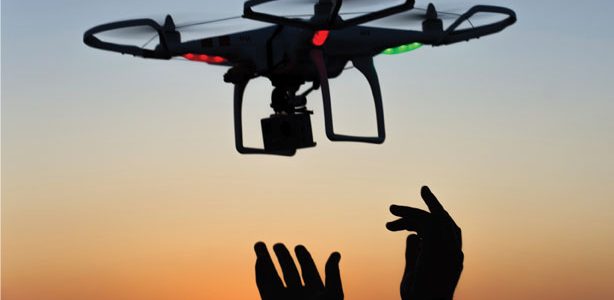“Commerical use” in the U.S. and around the world
Will significant new American UAV-powered businesses take flight in 2015? Maybe. Will innovators from overseas continue to invent, define and redefine commercial applications for small rotordrones at a much higher rate than their U.S. counterparts? Absolutely.
New use cases and successful business models for small, commercial UAVs, and the organizations that support them, are becoming more and more evident around the world. But the domestic environment for tomorrow’s early movers looks a lot like it did at the end of 2013. While American technology vendors and software developers building rotorcraft products continue to push forward with next-generation designs and integrated ecosystems, a swelling community of for-profit business entrepreneurs finds itself on the sidelines.
The Federal Aviation Administration’s Modernization and Reform Act of 2012 challenged the FAA with implementing clear regulatory guidelines to open up the market for commercial use of UAVs by September 30, 2015. Are they on target? Somewhat. But it is the “implementation” date(s) of forthcoming rules which will serve as the official grand opening for mass market entrants. In reality, a few missed regulatory deadlines, successful (or unsuccessful) lobbying campaigns or turnover among legislators could push the actual start dates for commercial enterprises offering aerial photography, video, surveying, precision agriculture, advertising, remote sensing, security and delivery services (among many, many others) well beyond 2015.
Many real estate marketers who had aggressively pushed forward with aerially enhanced property listings over the last few years have been forced to retire UAVs that directly enhanced their ability to sell property while the National Association of Realtors fights on their behalf. The NAR Board of Directors issued statement in November reminding their more than 1 million members that “the use of unmanned aerial vehicles for real estate marketing is currently prohibited by the Federal Aviation Administration. Such prohibited use of unmanned aerial vehicles may lead to the assessment of substantial fines and penalties.”
And now, the real estate market collectively joins the other 167 commercial entities that had submitted requests for FAA exemptions as of December 14, 2014.
In Twitter-speak, you might categorize 2014 as the year of hashtag #Exemptions.But as things seem to be moving slowly over here, there are a lot of interesting developments #overthere.
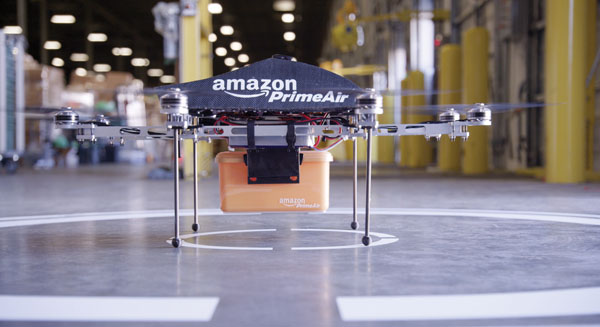
Feeling grounded: Amazon’s much-heralded Prime Air project will need years of testing and development in real-world conditions, but the company is known to aggressively attack new opportunities.
#EXEMPTIONS
So far, we have seen a handful of U.S. companies successfully navigate Section 333 of the 2013 FMRA. The FMRA’s “Special Rules for Certain Unmanned Aircraft Systems,” better known as Section 333, describe the interim policy which allows the agency to grant exemptions from regulations concerning general flight rules, pilot certifications, manuals, maintenance and hardware requirements. In addition, some airworthiness requirements can be waived to let specific UAVs operate in controlled, low-risk environments (such as closed movie sets).
“Unmanned aircraft offer a tremendous opportunity to spur innovation and economic activity by enabling many businesses to develop better products and services for their customers and the American public,” says U.S. Transportation Secretary Anthony Foxx. “We want to foster commercial uses of this exciting technology while taking a responsible approach to the safety of America’s airspace.”
The September announcement that a select group of aerial photo and video companies were granted Section 333 exemptions to operate on closed production sets was greeted with positive press. But it was years in the making. The work of the Motion Picture Association of America (MPAA) and many others to create a voluntary set of criteria played a great role in the announced exemptions for Aerial Mob, Astraeus Aerial Cinema Systems, Heli Video Productions, PictorVision, Snaproll Media and Vortex Aerial. (Flying-Cam Aerial Systems was also granted an exemption a short time later.)
In addition to the seven film and video production companies, a second wave of exemptions was announced December 10, 2014. Four companies were cleared to pursue narrowly-defined business applications in areas including aerial surveying, construction site monitoring and oil rig flare stack inspections as described in their submissions.
In announcing the Section 333 exemptions for Trimble Navigation Limited, VDOS Global, LLC, Clayco, Inc. and Woolpert, Inc. (which received two exemptions), the FAA also clarified that UAVs in the proposed operations don’t need an FAA-issued certificate of airworthiness because they do not pose a threat to national airspace users or national security.
Beyond the 167 organizations that will watch for any movement from the FAA over the next year is a sea of potential innovators with commercial ambitions. But they aren’t just individuals and small companies. Some of the largest companies around are frustrated that they can’t proceed as quickly as their technical know-how and business resource might allow.
A HOPE CYCLE BEGINS
Of all the milestones, redirects, progress, fear, creatively, uncertainty, innovation, hype, investment, doubt and growth that we have witnessed in 2014, the most significant American UAV event in 2014 actually occurred in 2013. December 1, 2013 to be exact.
That’s the day the Amazon CEO Jeff Bezos appeared on 60 Minutes. At the conclusion of his interview with veteran correspondent Charlie Rose, he escorted the producers and camera crew to a secret room that was set up to reveal the state of Amazon’s research into a new delivery model. Amazon “Prime Air” he announced, could fly small packages directly to a customer’s doorstep in 30 minutes from the time an order was placed on the company’s website. His acknowledgement that a great deal of safety testing and FAA approvals would be required did not phase audiences as much as his estimate that we could see such a service in as soon as 4-5 years. That pronouncement probably seemed like science fiction to the non-UAV crowd – and to many within the sector as well.
But the American media bought it. News of Amazon’s Prime Air experiments found favorable, front page coverage around the Internet and in almost every major news outlet … if only for its thought-provoking nature and futuristic visuals. While UAV veterans debated the viability of 10-mile round trip flights from the rural locations of Amazon’s fulfillment centers, the 60 Minutes segment also served as an “I told you so” moment for many of those with their own plans for UAV-oriented businesses.
Fast forward to December 2014. A company with the scale and resources of Amazon also finds itself on the sidelines. They are one of the companies that have submitted their very ambitious plans to the FAA. They are hiring top technical talent to further their research and development efforts. And they are frustrated. They want to fly at 50mph. They want to test rotorcraft with payloads of 5 pounds (representing 86% of the products sold on Amazon today). And they want to begin as soon as possible.
In a December 7, 2014 letter to the FAA to follow up on their exemption request, Amazon Vice President of Global Public Policy Paul Misener wrote, “To date, much of our Prime Air research and development efforts, including flight testing operations, have been conducted inside our laboratory and indoor testing facilities in Washington State. However, we must move beyond indoor testing if we are to realize the consumer benefits of Amazon Prime Air. In the absence of timely approval by the FAA to conduct outdoor testing, we have begun utilizing outdoor testing facilities outside the United States. These non-U.S. facilities enable us to quickly build and modify our Prime Air vehicles as we construct new designs and make improvements. It is our continued desire to also pursue fast-paced innovation in the United States, which would include the creation of high-quality jobs and significant investment in the local community. We believe this is what Congress intended when enacting Section 333, and it is why we continue to make every effort to seek this exemption.”
And so, that’s where they may be headed (for now). Over there. Overseas. To more open regulatory environments where they can put their R&D scenarios into real-world (outdoor) practice and further define the possibilities for Amazon Prime Air.
OVER THERE
The FAA has difficult work to do. And they must put public safety first. But the innovators will not wait.
By contrast, Canada has seen a sizable number of companies emerge to take advantage of their more defined regulatory environment. And it’s not just large companies seeking to fly 55-pound rotorcraft with military-grade operating systems that are making progress. It’s the real estate marketers, the aerial photographers and one-person-with-a-DJI-Phantom-and-a-great-idea concepts that are taking root and establishing new markets for revenue-producing services. In fact, Transport Canada, the department responsible for developing regulations, policies and services of transportation, issued 1,527 approvals for UAV operations between 2010 and 2013. They have had safety regulations in place that govern the use of UAVs since 1996.
Canadian aviation regulations have historically required Special Flight Operations Certificates so that Transport Canada can verify that operators can use their UAVs reliably and safely. The certificates mandate certain conditions based upon each specific use, such as maximum altitude, minimum distance from people and property, operating area, and coordination requirements with air traffic services.
On November 27, the department further catalyzed the growing market by issuing two new exemptions for “very small” 2kg (4 lb., 6.55 oz.) UAVs and “small” 2 to 25kg (55 lb., 1.8 oz.) UAVs that would eliminate the need for an SFOC if certain conditions are met.
“These exemptions mark an important milestone in UAV safety,” said Lisa Raitt, Canada’s Minister of Transport in a statement on the day of the announcement. “By easing restrictions for businesses, Canada is promoting growth and innovation in an important sector, while ensuring the continued safety of those on the ground and in the sky.”
Transport Canada posts the conditional information for operators of both weight classes at tc.gc.ca/SafetyFirst and recommends that users confirm that the exemptions apply to them. Some specialized applications will still require a Special Flight Operations Certificate in order to qualify.
Diana Cooper is head of the Unmanned Aerial Systems and Robotics Practice Group at Ottawa-based business law firm LaBarge Weinstein LLP, where she advises UAV companies on airspace regulations, intellectual property, privacy and commercial contracts. She has seen an ecosystem emerge within Canada over the last few years that is driving innovative new ideas and intellectual curiosity.
“UAVs raise interesting legal questions, for instance, surrounding expectations of privacy in public space or property rights in airspace,” she says. “There is also a great deal of excitement about the potential of UAVs and there are so many great startups coming up with interesting applications – it’s an exciting space to be in!”
She initially proposed a specialized practice dedicated to meeting the opportunities and challenges associated with the UAS and robotics sectors. “Because our firm is focused on the technology sector, and as a group, we are excited and passionate about emerging technologies, the partners were very supportive of my interest in UAS and robotics and so our Practice Group emerged.”
She sees videography and aerial photography as high-growth areas that will be further energized by the new 2kg class exemptions, while agriculture, mining, oil and gas applications should be well-served by the exemptions defined by the 25kg class.
“Although we have had a framework in place to support commercial UAV operations for years, until recently our system has placed a great deal of discretion in our regulator, Transport Canada,” she explains. “On the one hand, our framework has been beneficial as it has been flexible enough to support a rapidly evolving sector. On the flipside, not having clearly-defined rules has produced inefficiencies and many companies have endured long waits to obtain SFOC.”
As we enter 2015, we should be able to track the results of Canada’s increasing clarity as a result of Transport Canada’s new exemptions that will make it much easier for businesses to fly small UAVs safely and legally.
Some countries have no UAV regulations whatsoever. Others have started with limited rules only to react to negative incidents and retreat to an interim planning period like we have in the U.S., while some countries ban private UAVs completely.
What many American RotorDrone readers might hope to pursue at home one day is likely being done abroad. Today.
True innovators are emerging around the world, and it’s not hard to spot them. It’s like looking several years into the future. Their pioneering work will be studied and imitated. Perhaps they will bring years of UAV-based best practices to America when our markets open up. At the very least, they offer a framework for success that should not go unnoticed.
RUSSIA
“Dronevertising” is a c oncept that has been pioneered by the Moscow-based Hungry Boys agency. Founded in 2012 by industry veteran Vlad Sitnikov, who serves as CEO and creative director, the firm’s goal is to popularize creative promotional concepts for the Russian market. In a relatively short time, the company has attracted clients from both domestic organizations and global brands. They are as adept at print media as they are with social media, digital marketing and video production and especially proficient at combining each within integrated campaigns. Their work has been honored internationally with Golden Hammer, Cristal Festival and Webby awards. Their first UAV-based campaign was developed to support the Wokker (Bokkep) Asian restaurant chain.
oncept that has been pioneered by the Moscow-based Hungry Boys agency. Founded in 2012 by industry veteran Vlad Sitnikov, who serves as CEO and creative director, the firm’s goal is to popularize creative promotional concepts for the Russian market. In a relatively short time, the company has attracted clients from both domestic organizations and global brands. They are as adept at print media as they are with social media, digital marketing and video production and especially proficient at combining each within integrated campaigns. Their work has been honored internationally with Golden Hammer, Cristal Festival and Webby awards. Their first UAV-based campaign was developed to support the Wokker (Bokkep) Asian restaurant chain.

“Wokker CEO Aleksey Gisak challenged us with a task to promote his company without using any ordinary advertising instruments,” says Sitnikov. “We realized that it is necessary to talk to customers about the brand exactly when they want to eat. As we are always in search for extraordinary ideas, we have come up with the dronevertising idea almost at once.”
Using DJI Phantom 2 quadcopters featuring sleek printed banners with appeals for office workers to choose Wokker during their lunch break, the flying ads were circulated near key business centers. The Hungry Boys team delivered a first-of-its-kind campaign for Wokker which delivered tangible results: The number of orders at Wokker restaurants close to the business centers rose nearly 40 percent.
While the Aviation Code of the Russian Federation does not define restrictions for “dronevertising” currently, the Hungry Boys team has noticed an increased emphasis from the Federal Air Transport Agency to see that companies actively obtain certification for the use of rotor drones in the country’s airspace.
While the addition of flying promotions is just another tool for advertising agencies, and one that may not be repeated until Russian regulators create additional regulations for small UAVs, Sitnikov has expanded the company’s offerings by launching a new drone-based outfit. The Birdzzz Agency already has three dedicated employees and is working with organizations in other countries to expand the market for aerial brand experiences.
GERMANY

Christopher Kippenberger started out as an industrial design student in San Francisco and transitioned to cutting-edge film post-production work in Los Angeles and then to music video production in Europe. At every stop he developed a reputation for ultra-creative work that was seen as a departure from what much larger studios and agencies would offer. It’s no surprise that he found himself at the intersection of digital content and the nascent field of UAV videography several years ago. His Berlin-based Studio Kippenberger is seen as a preeminent producer of automobile-based content for some of the most notable brands and media outlets serving the industry.

Video compositions from Studio Kippenberger seem to use motion from captured objects or from camera movements in the way a painter uses brush strokes.
His recent work is reminiscent of the action sports videos that have helped define the cultures connected to surfing, skateboarding, snowboarding — but he does it with objects — offering a completely new look that makes the viewer forget the static shots of high-tech auto finery that are almost cliché in today’s television commercials or motorsports coverage. His look certainly owes some of its magic to the aerial shots that offer perspectives that haven’t been used time and time again. And that sometimes includes a dose of indoor UAV-based video work, as he recently composed in a Porsche Museum video for German auto magazine Ramp.
“As one of the early pioneers of the UAV industry it was really a lot like the wild west there,” he says, with few places to obtain information other than the RC community, “which as we all know is more happy with things being broken (so they can be repaired) than producing films.”
“First and foremost we are film makers so the drone was/is just a tool, sort of like a flying camera.”
In Germany, operators are required to obtain an “aufstiegs genehmigung” (or lift off authorization) for every flight, provide proof of insurance and operate on dedicated frequencies only (25MW, 5.8).
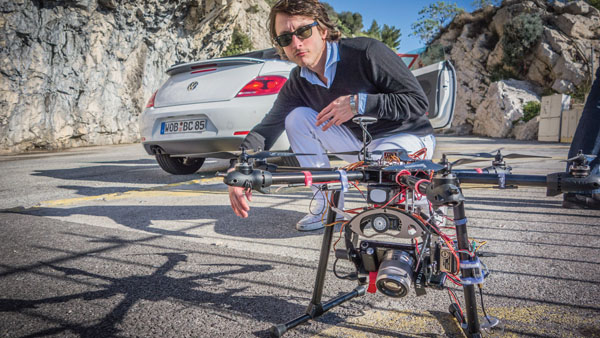
Christopher Kippenberger delivers creative content that sets his projects apart, but he often reinvents gimbal devices and steady-cam solutions to bring visions to life.
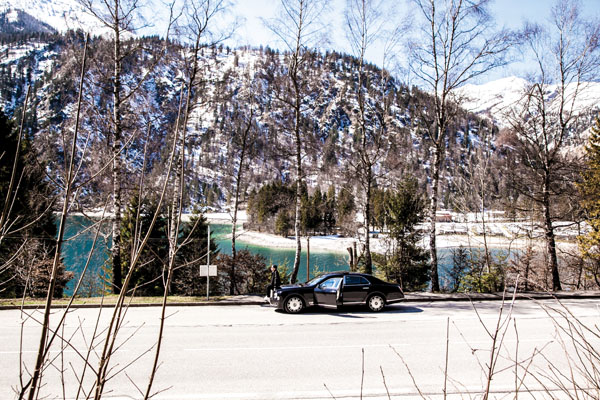
Nature plays an import role in Kippenberger-directed productions. UAVs are just one of many tools that allow him to capture automobiles, people and scenery in a unique style.
What may be most remarkable about Kippenberger’s contribution from the technology side, is that innovations in custom gimbal development on his highly modified UAVs have be repurposed back into the video world in the form of new handheld steady cam designs. In keeping with the tight control and slashed budgetary benchmarks reached by employing drone-based video capture methods in his productions, these new tools reduce the headcount needed to produce a variety of shots that previously required much larger crews and expense. A video for Vandeyk’s super high-end carbon fiber road bikes called “Machine for Riding” is representative of these new possibilities.
BRAZIL

Did you see any interesting Black Friday holiday sales campaigns that caught your attention this year? Retailers have an increasingly hard time competing with each other and the growing number of online sales channels. Year-end holiday sales can generate a massive percentage of overall revenues and top corporate marketing strategists can literally make or break their careers during this time.
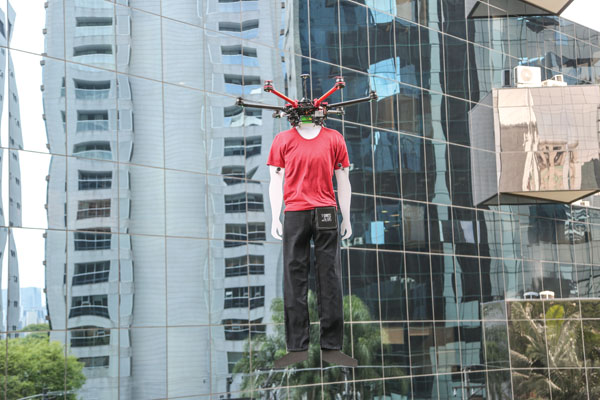
Desfile nas Alturas: This “parade on high” sales campaign from Brazilian retailer Camisaria Colombo shook up the advertising world in November.
Advertising executives were enthralled by what they saw from Brazilian menswear retailer Camisaria Colombo this holiday season. The commemorative “Desfile nas Alturas” video was a must-see for ad men and women around the world. Small UAVs supporting flat mannequin cutouts dressed in the latest Columbo sportswear flew directly adjacent to Sao Paulo high rises in the Vila Olímpia district – complete with sales price information. Bystanders simply couldn’t ignore the sight of these well-dressed silhouettes zooming overhead and office workers were drawn to a spectacle which would not be easy to forget.
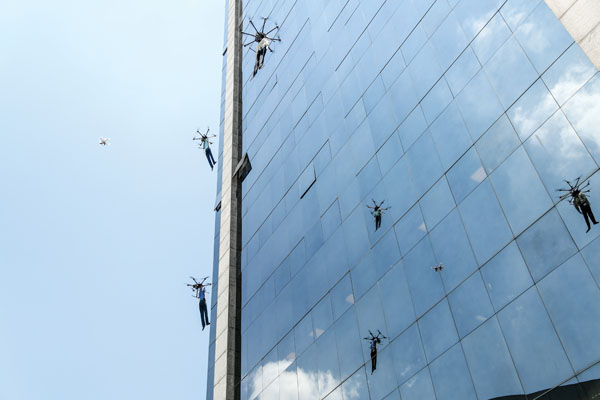
An upwardly mobile application of technology. Are aviation administrators ready to consider every UAV business case that can be imagined?
“The ‘Flying Collection’ was very successful,” said Caroline Saraiva, Marketing Manager of Camisaria Colombo. “The idea came from the perception that executives don’t have enough time to window shop. Therefore, Camisaria Colombo looked for an innovative way of being next to its public and to show that some offers are just impossible to miss. The publicity action was able to reach its goals, and was extremely reproduced on the media as well.”
UNITED KINGDOM

Horizon AP specializes in remotely piloted aerial systems for aerial photography, cinematography and data acquisition. It focuses on offering aerial services utilizing its own fleet of systems which are designed and built in-house. The company also provides custom-built systems, training and consultation to its clients.
With several years of experience in rotordrone sales, developing services based on small UAVs and training users, Jack Wrangham and Paddy Davies founded Horizon Aerial Photography Ltd. in 2010 and today have carved out of well-regarded niche in broadcast and media markets for providing aerial imagery content.

UK markets are developing rapidly. “With the lowering of the barriers to access (primarily cost and complexity) there is inevitably a huge increase in interest,” says Paddy Davies, Horizon AP Director and Operations Manager. “However there is a disconnect between the enthusiasm and the understanding of the air law. As such there has been a big increase in ‘violators’ who are operating outside of the regulations. This is not usually malicious but rather due to a lack of education.”
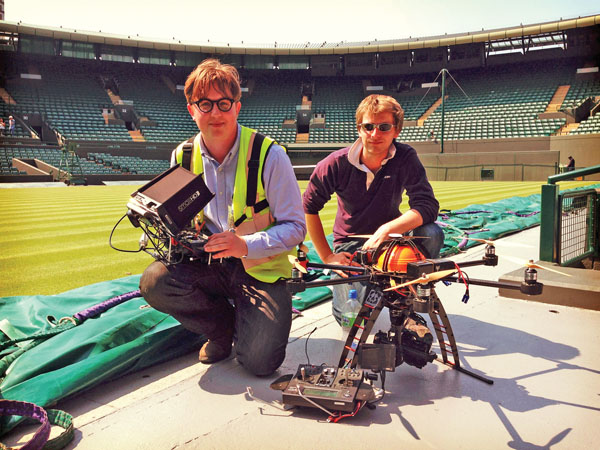
Founders Paddy Davies (left) and Jack Wrangham (right) have more than 10 years of combined experience in the RC and UAS sector and a reputation that is expanding as fast as their opportunities.
Trade association ARPAS-UK has been established to help educate people who are interested in participating in the industry. Davies believes that it is “key for commercial and non-commercial entities to stay safe and understand the limitations of this new capability.”
“The Civil Aviation Authority (CAA) have been one of the first airspace regulators to establish a legal framework and provide proper protection to this new market,” he says. “For that we are very grateful. We have set parameters which we must work within but that allow us to effectively and safely operate our business. The market in the UK is currently growing rapidly with approximately 350 licensed operators.”

Horizon AP is at the forefront of an emerging industry and serves as a model of what is possible in a clearly regulated market.
“In the UK the CAA require you to provide evidence of competency which is assessed through the production of a Flight Operations Manual in conjunction with evidence of experience and knowledge of safe air operations,” he continues. “The key qualification for this is a either a BNUC-S [Basic National UAS Certificate] from EuroUSC or a RPQS [Remotely Piloted Aircraft Systems qualification] from Resource UAS. Both are valid and well-developed courses that offer the simplest access to proof of competency.”


